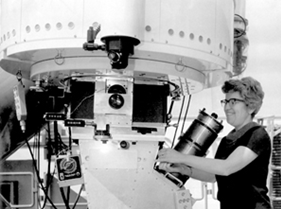- 1610: Galileo
- 1676: Ole Rømer
- 1687: Isaac Newton
- 1781: William Herschel
- 1838: Friedrich Bessel
- 1861: William and Margaret Huggins
- 1912: Henrietta Leavitt
- 1917 Einstein
- 1920: Harlow Shapley
- 1929 Edwin Hubble
- 1948: Ralph Alpher
- 1949: Fred Hoyle
- 1963: Maarten Schmidt
- 1964: Arno Penzias and Robert Wilson
- 1978: Vera Rubin and Kent Ford
- 1989: Margaret Geller and John Huchra
- 1992: John Mather and George Smoot
- 1995: Robert Williams
- 1998: Saul Perlmutter and Brian Schmidt
- 2010: Wendy Freedman
Kent Ford’s Image Tube Spectrograph on the 2.1-Meter Telescope at Kitt Peak
 |
Above: Vera Rubin operating the 2.1-meter telescope at Kitt Peak, 1970. Courtesy of National Optical Astronomy Observatory (NOAO)/AURA/NSF. The spectrograph mounts on the end of the telescope and records an image of the spectrum (colors) of a small section of a galaxy.
Left: 2.1-meter (84-inch) telescope at Kitt Peak National Observatory. Courtesy of NOAO/AURA/NSF.
|
Rubin and Ford were not the first to propose the idea of dark matter. That honor goes to astronomer Fritz Zwicky who observed clusters of galaxies in 1933 and estimated that they must have more matter than was visible, in order for the clusters of galaxies to be held together. But Rubin and Ford were the first to provide firm evidence of dark matter as a result of careful measurements of the rotation rates of galaxies.
Since no one has yet discovered the nature of dark matter, some astronomers proposed that dark matter does not exist, and that there is some other reason for the rotation rate of galaxies. However, in 2006 NASA announced that the Chandra X-Ray satellite found further strong evidence that dark matter exists.
